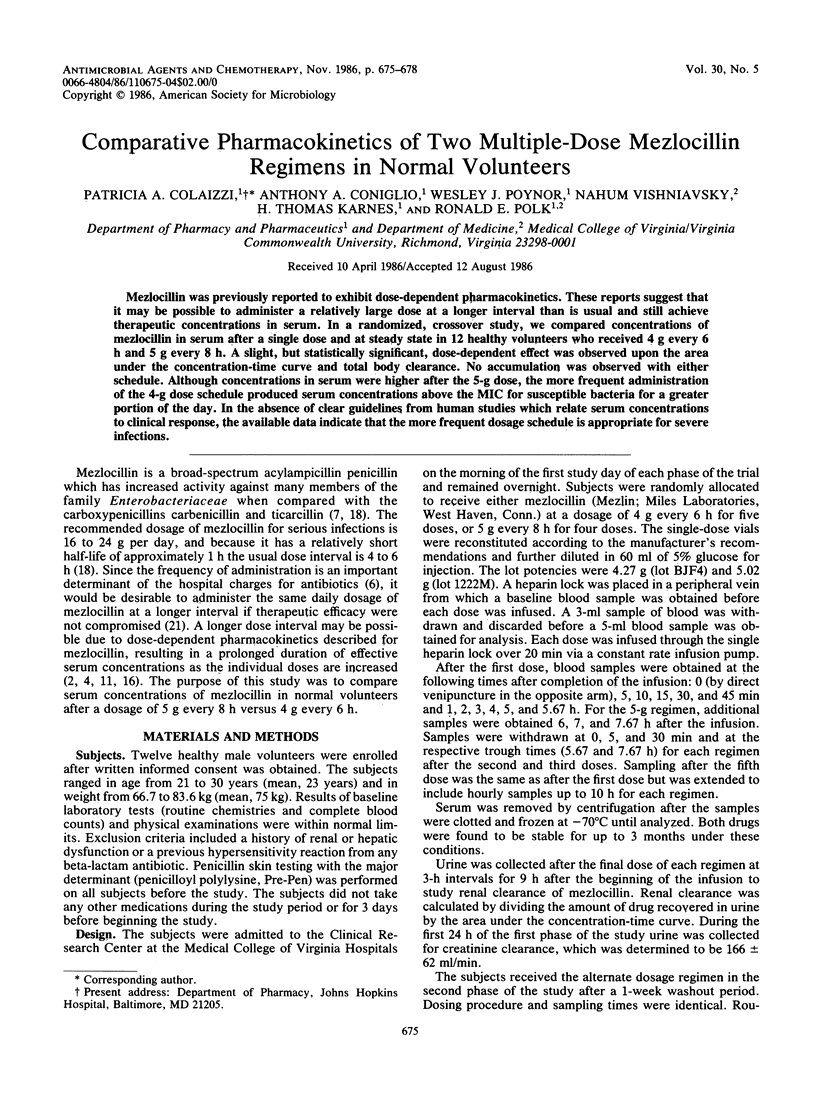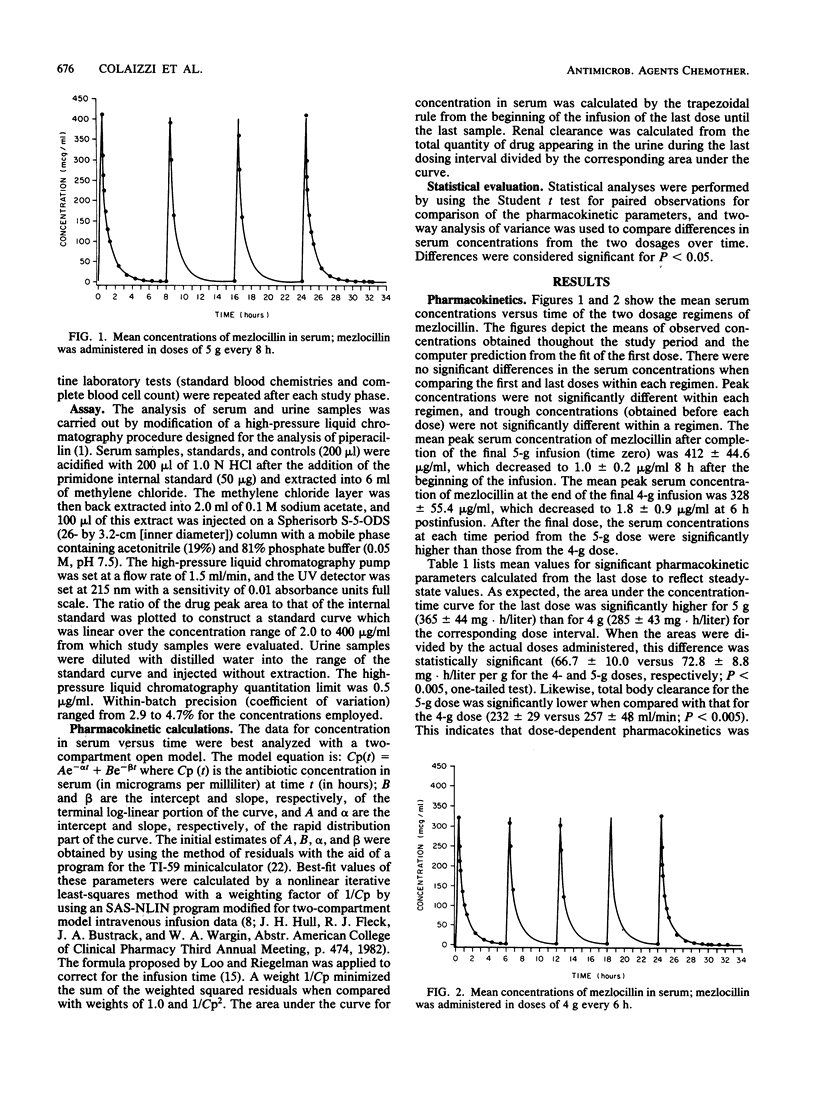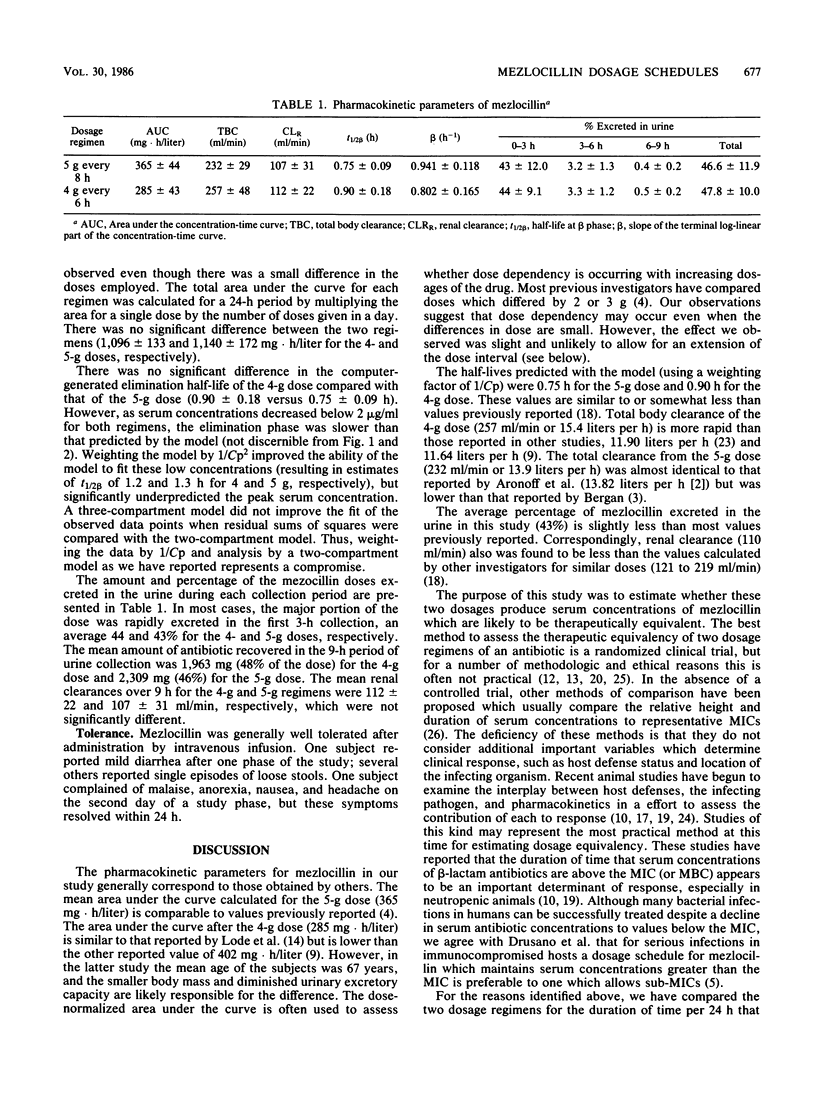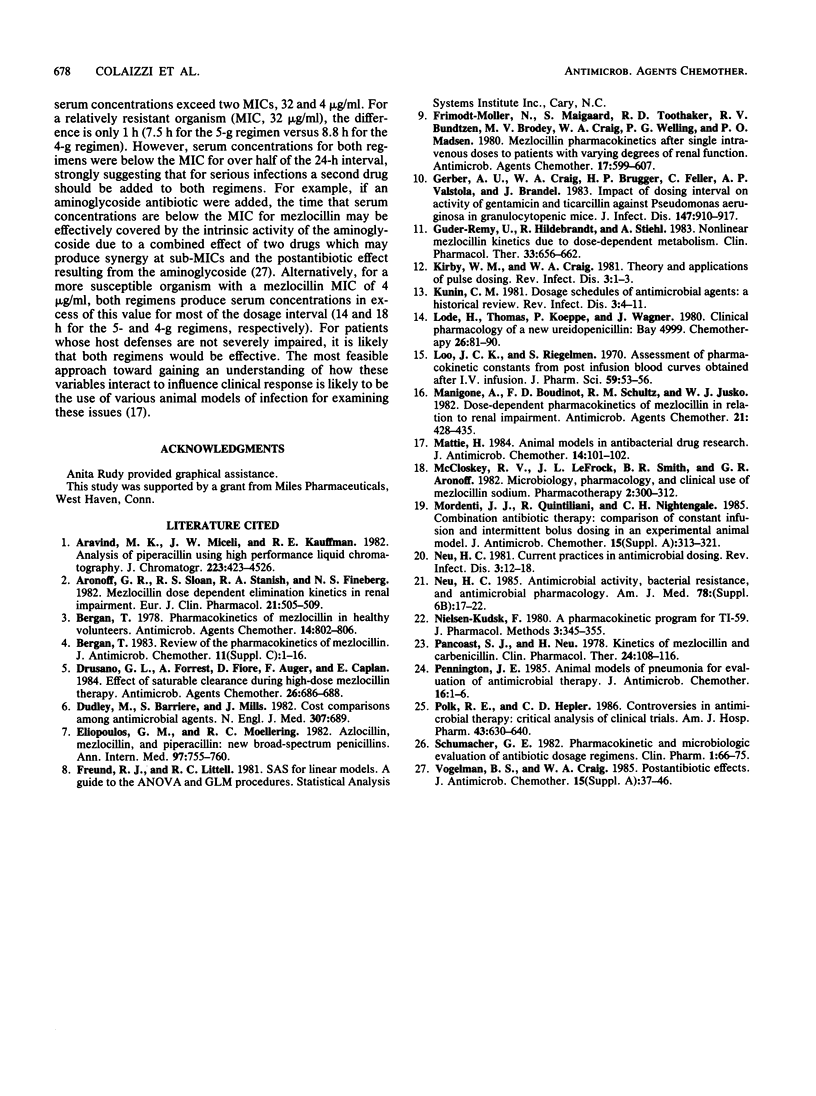Abstract
Mezlocillin was previously reported to exhibit dose-dependent pharmacokinetics. These reports suggest that it may be possible to administer a relatively large dose at a longer interval than is usual and still achieve therapeutic concentrations in serum. In a randomized, crossover study, we compared concentrations of mezlocillin in serum after a single dose and at steady state in 12 healthy volunteers who received 4 g every 6 h and 5 g every 8 h. A slight, but statistically significant, dose-dependent effect was observed upon the area under the concentration-time curve and total body clearance. No accumulation was observed with either schedule. Although concentrations in serum were higher after the 5-g dose, the more frequent administration of the 4-g dose schedule produced serum concentrations above the MIC for susceptible bacteria for a greater portion of the day. In the absence of clear guidelines from human studies which relate serum concentrations to clinical response, the available data indicate that the more frequent dosage schedule is appropriate for severe infections.
Full text
PDF



Selected References
These references are in PubMed. This may not be the complete list of references from this article.
- Aravind M. K., Miceli J. N., Kauffman R. E. Analysis of piperacillin using high-performance liquid chromatography. J Chromatogr. 1982 Dec 10;233:423–426. doi: 10.1016/s0378-4347(00)81779-x. [DOI] [PubMed] [Google Scholar]
- Aronoff G. R., Sloan R. S., Stanish R. A., Fineberg N. S. Mezlocillin dose dependent elimination kinetics in renal impairment. Eur J Clin Pharmacol. 1982;21(6):505–509. doi: 10.1007/BF00542046. [DOI] [PubMed] [Google Scholar]
- Bergan T. Pharmacokinetics of mezlocillin in healthy volunteers. Antimicrob Agents Chemother. 1978 Dec;14(6):801–806. doi: 10.1128/aac.14.6.801. [DOI] [PMC free article] [PubMed] [Google Scholar]
- Bergan T. Review of the pharmacokinetics of mezlocillin. J Antimicrob Chemother. 1983 May;11 (Suppl 100):1–16. doi: 10.1093/jac/11.suppl_c.1. [DOI] [PubMed] [Google Scholar]
- Drusano G. L., Forrest A., Fiore D., Auger F., Caplan E. S. Effect of saturable clearance during high-dose mezlocillin therapy. Antimicrob Agents Chemother. 1984 Nov;26(5):686–688. doi: 10.1128/aac.26.5.686. [DOI] [PMC free article] [PubMed] [Google Scholar]
- Dudley M., Barriere S., Mills J. Cost comparisons among antimicrobial agents. N Engl J Med. 1982 Sep 9;307(11):689–689. doi: 10.1056/NEJM198209093071120. [DOI] [PubMed] [Google Scholar]
- Eliopoulos G. M., Moellering R. C., Jr Azlocillin, mezlocillin, and piperacillin: new broad-spectrum penicillins. Ann Intern Med. 1982 Nov;97(5):755–760. doi: 10.7326/0003-4819-97-5-755. [DOI] [PubMed] [Google Scholar]
- Frimodt-Möller N., Maigaard S., Toothaker R. D., Bundtzen R. W., Brodey M. V., Craig W. A., Welling P. G., Madsen P. O. Mezlocillin pharmacokinetics after single intravenous doses to patients with varying degrees of renal function. Antimicrob Agents Chemother. 1980 Apr;17(4):599–607. doi: 10.1128/aac.17.4.599. [DOI] [PMC free article] [PubMed] [Google Scholar]
- Gerber A. U., Craig W. A., Brugger H. P., Feller C., Vastola A. P., Brandel J. Impact of dosing intervals on activity of gentamicin and ticarcillin against Pseudomonas aeruginosa in granulocytopenic mice. J Infect Dis. 1983 May;147(5):910–917. doi: 10.1093/infdis/147.5.910. [DOI] [PubMed] [Google Scholar]
- Gundert-Remy U., Hildebrandt R., Stiehl A., Weber E. Nonlinear mezlocillin kinetics due to dose-dependent metabolism. Clin Pharmacol Ther. 1983 May;33(5):656–662. doi: 10.1038/clpt.1983.89. [DOI] [PubMed] [Google Scholar]
- Kirby W. M., Craig W. A. Theory and applications of pulse dosing: a summary of the symposium. Rev Infect Dis. 1981 Jan-Feb;3(1):1–3. doi: 10.1093/clinids/3.1.1. [DOI] [PubMed] [Google Scholar]
- Kunin C. M. Dosage schedules of antimicrobial agents: a historical review. Rev Infect Dis. 1981 Jan-Feb;3(1):4–11. doi: 10.1093/clinids/3.1.4. [DOI] [PubMed] [Google Scholar]
- Lode H., Tomas W., Koeppe P., Wagner J. Clinical pharmacology of a new ureidopenicillin: Bay K 49999. Chemotherapy. 1980;26(2):81–90. doi: 10.1159/000237887. [DOI] [PubMed] [Google Scholar]
- Loo J. C., Riegelman S. Assessment of pharmacokinetic constants from postinfusion blood curves obtained after I.V. infusion. J Pharm Sci. 1970 Jan;59(1):53–55. doi: 10.1002/jps.2600590107. [DOI] [PubMed] [Google Scholar]
- Mangione A., Boudinot F. D., Schultz R. M., Jusko W. J. Dose-dependent pharmacokinetics of mezlocillin in relation to renal impairment. Antimicrob Agents Chemother. 1982 Mar;21(3):428–435. doi: 10.1128/aac.21.3.428. [DOI] [PMC free article] [PubMed] [Google Scholar]
- Mattie H. Animal models in antibacterial drug research. J Antimicrob Chemother. 1984 Aug;14(2):101–102. doi: 10.1093/jac/14.2.101. [DOI] [PubMed] [Google Scholar]
- McCloskey R. V., LeFrock J. L., Smith B. R., Aronoff G. R. Microbiology, pharmacology, and clinical use of mezlocillin sodium. Pharmacotherapy. 1982 Nov-Dec;2(6):300–312. doi: 10.1002/j.1875-9114.1982.tb03204.x. [DOI] [PubMed] [Google Scholar]
- Mordenti J. J., Quintiliani R., Nightingale C. H. Combination antibiotic therapy: comparison of constant infusion and intermittent bolus dosing in an experimental animal model. J Antimicrob Chemother. 1985 Jan;15 (Suppl A):313–321. doi: 10.1093/jac/15.suppl_a.313. [DOI] [PubMed] [Google Scholar]
- Neu H. C. Antimicrobial activity, bacterial resistance, and antimicrobial pharmacology. Is it possible to use new agents cost-effectively? Am J Med. 1985 Jun 28;78(6B):17–22. doi: 10.1016/0002-9343(85)90358-4. [DOI] [PubMed] [Google Scholar]
- Neu H. C. Current practices in antimicrobial dosing. Rev Infect Dis. 1981 Jan-Feb;3(1):12–18. doi: 10.1093/clinids/3.1.12. [DOI] [PubMed] [Google Scholar]
- Nielsen-Kudsk F. A pharmacokinetic program for TI-59. J Pharmacol Methods. 1980 Jun;3(4):345–355. doi: 10.1016/0160-5402(80)90076-5. [DOI] [PubMed] [Google Scholar]
- Pancoast S. J., Neu H. C. Kinetics of mezlocillin and carbenicillin. Clin Pharmacol Ther. 1978 Jul;24(1):108–116. doi: 10.1002/cpt1978241108. [DOI] [PubMed] [Google Scholar]
- Pennington J. E. Animal models of pneumonia for evaluation of antimicrobial therapy. J Antimicrob Chemother. 1985 Jul;16(1):1–4. doi: 10.1093/jac/16.1.1. [DOI] [PubMed] [Google Scholar]
- Polk R. E., Hepler C. D. Controversies in antimicrobial therapy: critical analysis of clinical trials. Am J Hosp Pharm. 1986 Mar;43(3):630–640. [PubMed] [Google Scholar]
- Schumacher G. E. Pharmacokinetic and microbiologic evaluation of antibiotic dosage regimens. Clin Pharm. 1982 Jan-Feb;1(1):66–75. [PubMed] [Google Scholar]
- Vogelman B. S., Craig W. A. Postantibiotic effects. J Antimicrob Chemother. 1985 Jan;15 (Suppl A):37–46. doi: 10.1093/jac/15.suppl_a.37. [DOI] [PubMed] [Google Scholar]


